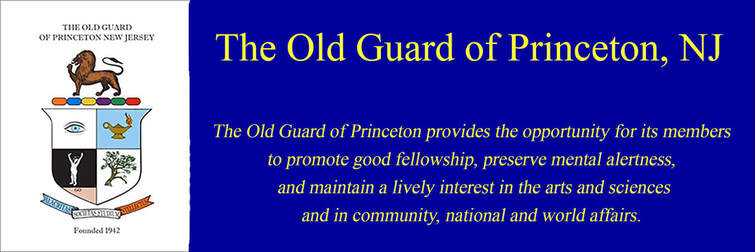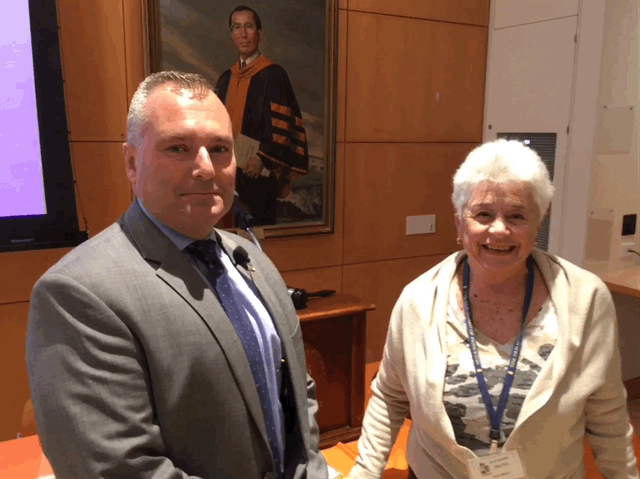November 1, 2017
Contemporary Issues in Princeton Policing
Nick Sutter
Princeton Chief of Police
November 1, 2017
Minutes of the Eighth Meeting of the 76th Year
President McFarlane called the meeting to order at 10:15a.m. There were 96 in attendance. The invocation was led by Julie Denny, and the minutes for the previous meeting were read by David Egger. Two members introduced guests: Julie Denny, John Clark and Gerald Berkelhammer, Sheila Berkelhammer.
Ruth Miller introduced The Princeton chief of police, Nick Sutter, to address the subject, “Contemporary Issues in Princeton Policing.” He has been the chief since the consolidation of Princeton Borough and Township, having previously served in many capacities in the former borough department.
He began his presentation with a discussion of the issues associated with the consolidation of the two departments. Although they did the same fundamental job, they had their distinct histories, procedures and, most important, their cultures.
They started the process of combining by having all 60 officers work together to identify their values, which they determined to be honor, integrity, service and knowledge. Chief Sutter emphasized that this was a bottom-up process, not top down. The effort was complicated by a wide range in years of service and ended up dealing with such minor issues as a standard for shoes.
The most basic, but complex, task was to establish a common culture. That was done by assessing organizational health, doing personnel assessments to match personal strengths with position needs and to determine the community needs and wants by contacting a wide range of government, commercial and citizen organizations. On the basis of those evaluations, the department developed a strategic plan with five goals:
Chief Sutter said that to his knowledge that type of assessment and cultural adjustment is unique in police organizations and was facilitated by the consolidation so they were dealing with a new department and did not have to spend a lot of time assessing past problems. It was very future focused.
The chief mentioned two more things about the creation of the new department.
After focusing on the Princeton consolidation, Chief Sutter reviewed some national trends and themes affecting local policing. Those included:
Following his remarks, there was a wide-ranging Q&A session with questions covering, among other things, body cameras, the relationship with the university, local opioid trends and specific local traffic issues.
Respectfully submitted,
William Wakefield
Ruth Miller introduced The Princeton chief of police, Nick Sutter, to address the subject, “Contemporary Issues in Princeton Policing.” He has been the chief since the consolidation of Princeton Borough and Township, having previously served in many capacities in the former borough department.
He began his presentation with a discussion of the issues associated with the consolidation of the two departments. Although they did the same fundamental job, they had their distinct histories, procedures and, most important, their cultures.
They started the process of combining by having all 60 officers work together to identify their values, which they determined to be honor, integrity, service and knowledge. Chief Sutter emphasized that this was a bottom-up process, not top down. The effort was complicated by a wide range in years of service and ended up dealing with such minor issues as a standard for shoes.
The most basic, but complex, task was to establish a common culture. That was done by assessing organizational health, doing personnel assessments to match personal strengths with position needs and to determine the community needs and wants by contacting a wide range of government, commercial and citizen organizations. On the basis of those evaluations, the department developed a strategic plan with five goals:
- Increase traffic and pedestrian safety
- Increase organizational efficiency and accountability
- Maintain professional development and training
- Leverage crime and traffic analytics
- Provide superior community engagement
Chief Sutter said that to his knowledge that type of assessment and cultural adjustment is unique in police organizations and was facilitated by the consolidation so they were dealing with a new department and did not have to spend a lot of time assessing past problems. It was very future focused.
The chief mentioned two more things about the creation of the new department.
- In the recruiting process, they are focused on attitude more than aptitude. In dealing with the public, attitude is often more important and attitude is harder to change and train than aptitude.
- The department has achieved minority representation on the force that is representative of the local population.
After focusing on the Princeton consolidation, Chief Sutter reviewed some national trends and themes affecting local policing. Those included:
- Avoiding some past practices, for example “broken-window policing,” which, if overemphasized and implemented without sufficient discretion, can become discriminatory against minority communities.
- The need for the police to be seen as guardians of the community without a warrior mindset.
- The need for second responders to care for opioid victims after the police deal with them as first responders and “stabilizers.”
- The police have an active program with the schools and others to be prepared as well as possible to respond to terrorist activity.
- The Princeton police will abide by the New Jersey attorney general’s policy for dealing with immigration violators and will remain a “welcoming city.”
Following his remarks, there was a wide-ranging Q&A session with questions covering, among other things, body cameras, the relationship with the university, local opioid trends and specific local traffic issues.
Respectfully submitted,
William Wakefield

